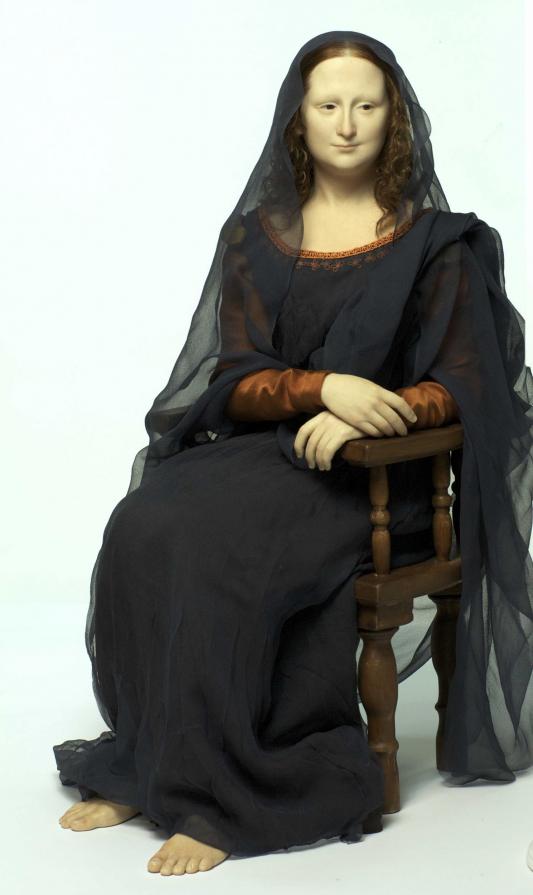
Hypersonage: Monna Lisa
HYPERSONAGE Monna Lisa is one out of a serie. At a first level of interpretation, the inspiring principle of the serie HYPERSONAGEs is conceptually quite easy to pin down: they are a reproposals, in a hyperrealistic key, of subjects which have become actual characters in the narrative of a globalized Art, according to the rather incongruous logic inherent in mass cultures, in the pop aesthetics, and in the phenomenology of cult.
At the same time, a more detailed discussion can be developed on HYPERSONAGEs.
Since the early beginnings of the so-called "death of Art" and the early signs of what would eventually become the historical avant-gardes, artists have begun to reflect and dispute over Art through reinterpretations, and deliberate misinterpretations, of its most celebrated instances; for instance the "Mona Lisa fumant le pipe", by Eugène Bataille, which was presented in 1883, blatantly foreshadowing the two L.H.O.O.Q. by Marcel Duchamp, the first one dated 1919 (as well as many other Monna Lisa that will follow).
It is not a question of a rhetoric of demystification or parody, as it has deep roots in the same crisis of modern Art which, through the anti-art of the nineteenth century avant-gardes, and the aesthetisation of the image carried to the last (till the anaesthetisation for the images), eventually led to the process of "dematerialization of the art object" (the same Bataille can be considered a conceptual artist avant la lettre, a precursor but not the only one at his time).
Instead, the parallel process of de-realization, characteristic of contemporary Art, collapses into a play of hyper-realization in HYPERSONAGEs .
This effect is obtained through the alienation of its classical texts, masterpieces today deprived of any form of aura, reduced to the function of icons of mass culture/market: alienated, in fact, in the hyper-reality that is described by Jean Baudrillard as a hallucinated and mystifying fiction.
It almost appears as a senile disease of Art which, in the contemporary age, does not find any space for an actual regeneration.
Back to reality, e.g. by following the path traced by certain current philosophy −according to which, among other things, the denial of objective reality is quite reactionary− is a way to bring back the art to its intrinsic nature, you can not reset.
Therefore the HYPERSONAGEs seem to step back, bringing the unreality of the artistic fenomenology back to reality, through an escamotage, i.e. the illusion of realism –or, in fact, the hyperrealist rhetoric.
The hyperreality of HYPERSONAGEs declines also on two levels: the hyperrealism, which is a technical and aesthetic matter, being inscribed in a generally recognized contemporary arts’ genre; and hypertextuality, as the artworks are the hypertext which hypotexts are easily recognizable in artworks that inspired them and which are universally known, just like starlets in the show of a globalized history of arts.
In this way the hyperrealism is drawn away from the body of reality and takes body in the Art itself, mimicking a kind of parousia, while still aware that it is just a fata morgana.
In fact, it is always a matter of illusion, and this illusive statute shines through the play of scale, because illusion flaunts herself and is shown up, while not disappearing.
The HYPERSONAGEs seem therefore to come out of Art history by clichés, emancipating from their contexts, which are the original artworks (the hypotexts), which −like Alice through the mirror− find themselves in Wonderland: they look at the world and are looked at, while nobody is really able to understand which is more illusory, because one reflects the illusory nature of the other one, in a mise en abîme that apparently leaves no escape.
Can one still hope to denounce the illusory misalliance between a massifying Pleasure Principle and the Reality Principle? Can one hope to do so thanks to the rethorical instrumentarium of contemporary Art?
The HYPERSONAGEs attempt to achieve this coincidentia oppositorum, they are the embodiment of a living aporia in Art, they are a prosopopoeia.





















Comments 4
saluti
Say something